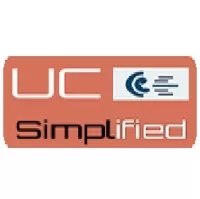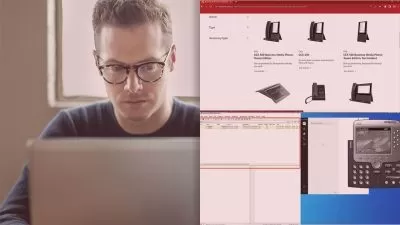Voice Logic: A 5-Day Journey into Voice Technology and SIP
UC Simplified
5:01:19
Description
Telephony , VoIP , SIP & Beyond
What You'll Learn?
- Understand how Telephony works and what is VOIP
- Voice Revolution and how we are transitioning from ISDN to SIP
- Journey into SIP components & Architecture
- What compromises a Good Call Flow
- Is it Signaling or is It media and how SDP works
- Modern Applications & Terminologies in Voice Technology
Who is this for?
What You Need to Know?
More details
DescriptionIntroduction to voice technology and VoIP. Define voice technology, VoIP, SIP and other related terms. Explain the difference between VoIP and traditional phone services. Give an overview of the history and evolution of voice technology and VoIP.
Benefits and challenges of VoIP. Discuss the advantages of using VoIP, such as cost savings, flexibility, scalability and integration. Identify the challenges of using VoIP, such as bandwidth, security, compatibility and quality.
VoIP protocols and standards. Explain the technical aspects of how VoIP works, such as the transmission of voice packets over the internet. Describe the main protocols and standards that enable VoIP, such as TCP,UDP, RTP, SIP, SDP and others.
What is SIP and why is it important? Define SIP and explain its role and function in VoIP and multimedia communication. Describe the benefits and challenges of using SIP. Provide some examples of SIP applications and features.
How does SIP work? Explain the basic concepts and components of SIP, such as SIP address, SIP message, SIP session, SIP transaction, SIP dialog, etc. Illustrate the process of establishing, modifying and terminating a SIP session. Compare and contrast SIP with other protocols, such as H.323.
What are the types and formats of SIP messages? Identify the two types of SIP messages: requests and responses. Explain the purpose and function of each type of SIP request and response. Describe the format and structure of a SIP message, including the start line, headers and body. Provide some examples of common SIP headers and their values.
Explain the role and function of different types of SIP servers, such as proxy server, redirect server, registrar server, etc. Illustrate how SIP messages are routed between different SIP servers and endpoints.
How are SIP components identified and authenticated? Define and explain the concept and function of SIP domains and realms. Describe the format and structure of a SIP address or URI.
Explain how SIP works with other network protocols and services that are essential for VoIP and multimedia communication, such as DNS, DHCP, NTP, RTP, RTCP, SDP, etc.
Discover B2BUAÂ &Â SIPÂ Trunks.
Define and explain the concept and function of call flow in SIP. Describe the difference between signaling and media in VoIP and multimedia sessions. Explain the benefits and challenges of analyzing call flow in SIP.
Explain the process and mechanism of signaling in SIP, such as SIP requests, responses, transactions, dialogs and sessions. Describe the types and formats of SIP requests and responses, such as INVITE, ACK, BYE, OK, etc. Illustrate the basic call flow for a SIP session establishment, modification and termination.
Explain the process and mechanism of media in SIP, such as RTP, RTCP, SDP, codecs, etc.
Discuss some common call flow scenarios in SIP, such as call forking, call transfer, call hold, call resume, etc. Describe the purpose and function of each scenario. Illustrate the message sequence and ladder diagram for each scenario. Compare and contrast the signaling and media aspects of each scenario.
Discover modern terminologies &Â Components used in VoIPÂ like Media Gateways (GW), Session Border Controllers (SBC) and Private Branch Exchange (PBX).
Understand NATÂ Issue with VoIP and how Interactive Connectivity Establishment (ICE) Framework is used and Learn about Media Bypass.
Who this course is for:
- Voice enthusiasts who want to explore the world of voice technology and Session Initiation Protocol (SIP)
- Voice engineers who want to refresh their knowledge or use this as primer to transition to SIP
Introduction to voice technology and VoIP. Define voice technology, VoIP, SIP and other related terms. Explain the difference between VoIP and traditional phone services. Give an overview of the history and evolution of voice technology and VoIP.
Benefits and challenges of VoIP. Discuss the advantages of using VoIP, such as cost savings, flexibility, scalability and integration. Identify the challenges of using VoIP, such as bandwidth, security, compatibility and quality.
VoIP protocols and standards. Explain the technical aspects of how VoIP works, such as the transmission of voice packets over the internet. Describe the main protocols and standards that enable VoIP, such as TCP,UDP, RTP, SIP, SDP and others.
What is SIP and why is it important? Define SIP and explain its role and function in VoIP and multimedia communication. Describe the benefits and challenges of using SIP. Provide some examples of SIP applications and features.
How does SIP work? Explain the basic concepts and components of SIP, such as SIP address, SIP message, SIP session, SIP transaction, SIP dialog, etc. Illustrate the process of establishing, modifying and terminating a SIP session. Compare and contrast SIP with other protocols, such as H.323.
What are the types and formats of SIP messages? Identify the two types of SIP messages: requests and responses. Explain the purpose and function of each type of SIP request and response. Describe the format and structure of a SIP message, including the start line, headers and body. Provide some examples of common SIP headers and their values.
Explain the role and function of different types of SIP servers, such as proxy server, redirect server, registrar server, etc. Illustrate how SIP messages are routed between different SIP servers and endpoints.
How are SIP components identified and authenticated? Define and explain the concept and function of SIP domains and realms. Describe the format and structure of a SIP address or URI.
Explain how SIP works with other network protocols and services that are essential for VoIP and multimedia communication, such as DNS, DHCP, NTP, RTP, RTCP, SDP, etc.
Discover B2BUAÂ &Â SIPÂ Trunks.
Define and explain the concept and function of call flow in SIP. Describe the difference between signaling and media in VoIP and multimedia sessions. Explain the benefits and challenges of analyzing call flow in SIP.
Explain the process and mechanism of signaling in SIP, such as SIP requests, responses, transactions, dialogs and sessions. Describe the types and formats of SIP requests and responses, such as INVITE, ACK, BYE, OK, etc. Illustrate the basic call flow for a SIP session establishment, modification and termination.
Explain the process and mechanism of media in SIP, such as RTP, RTCP, SDP, codecs, etc.
Discuss some common call flow scenarios in SIP, such as call forking, call transfer, call hold, call resume, etc. Describe the purpose and function of each scenario. Illustrate the message sequence and ladder diagram for each scenario. Compare and contrast the signaling and media aspects of each scenario.
Discover modern terminologies &Â Components used in VoIPÂ like Media Gateways (GW), Session Border Controllers (SBC) and Private Branch Exchange (PBX).
Understand NATÂ Issue with VoIP and how Interactive Connectivity Establishment (ICE) Framework is used and Learn about Media Bypass.
Who this course is for:
- Voice enthusiasts who want to explore the world of voice technology and Session Initiation Protocol (SIP)
- Voice engineers who want to refresh their knowledge or use this as primer to transition to SIP
User Reviews
Rating
UC Simplified
Instructor's Courses
Udemy
View courses Udemy- language english
- Training sessions 31
- duration 5:01:19
- Release Date 2023/10/29










